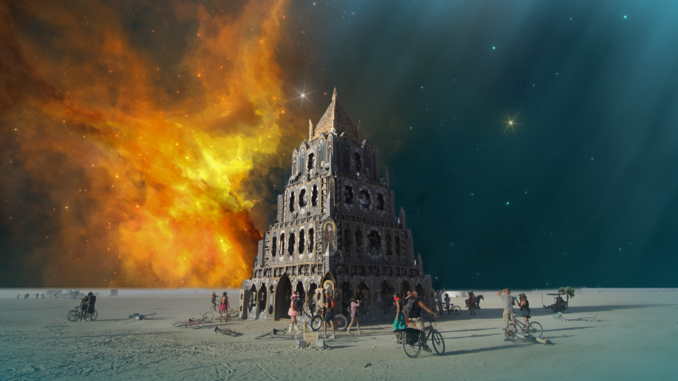
Rohan Roberts | 9th September 2016
There was a moment at Burning Man when I stood gazing at everything around me and I kept saying over and over again: “Look at this! Just LOOK AT THIS! It’s amazing! It’s amazing! It’s amazing! It’s amazing….” I said it over 50 times!!! I was lost for words! Me – a linguist, a wordsmith, an English double major, a published author, a voracious reader, a prolific writer, a teacher of Literature… all I could say about the splendour and magic of Burning man was “it is so amazing.”
When it comes to Burning Man, the pen falters, the lexicon fails, and the keyboard refuses to yield a better description. The Muses expire, Pegasus wilts, and language falls short and proves inadequate if I tried to use words to describe how AMAZING (that word again) Burning Man was.
After travelling to 64 countries and over 200 cities it’s not difficult to become a touch jaded. But Burning Man will shake the senses of even the most world-weary traveller dulled by surfeit. To say the experience is therapeutic is to put it mildly. To aver that it is transformative is cutting closer to the bone. To declare that it is a transcendental experience that elevates the mind, sucker-punches the body, and cleanses the soul is to make some inroads into what Burning Man does to you.
What is Burning Man?
By now the uninitiated reader will be irritable. What the hell is Burning Man? Some people think it’s a mutant version of Glastonbury or Coachella or Shambhala or any number of vapid, commercial, soulless mainstream EDM music festivals. Burning Man is not a music festival. Burning Man is unlike anything on this planet.
“Burning Man is an annual gathering that takes place at Black Rock City—a temporary community erected in the Black Rock Desert in Nevada. The event is described as an experiment in community and art, influenced by 10 main principles, including ‘radical’ inclusion, self-reliance and self-expression, as well as community cooperation, civic responsibility, gifting, decommodification, participation, immediacy and leaving no trace.
“At Burning Man the community explores various forms of artistic self-expression, created in celebration for the pleasure of all participants. Participation is a key precept for the community – selfless giving of one’s unique talents for the enjoyment of all is encouraged and actively reinforced. Some of these generous outpourings of creativity can include experimental and interactive sculpture, building, performance, and art cars among other mediums, often inspired by the yearly theme, chosen by organisers. The event takes its name from its culmination, the symbolic ritual burning of a large wooden effigy (‘the Man’) that traditionally occurs on the Saturday evening of the event.”
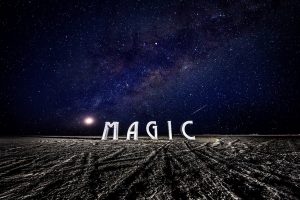 But in addition to that slightly desiccated description above, Burning Man is – to employ a few metaphors – a crucible of creativity; a vortex of artistry; a whimsical fairyland; a spa for the mind; a metamorphosis of the soul; a raging, surreal maelstrom of lights, colours, sounds, emotions, and experiences. At its core, Burning Man is an experiment in alternative living; an outpouring of generosity; and a celebration of the human spirit, human imagination, and human ingenuity.
But in addition to that slightly desiccated description above, Burning Man is – to employ a few metaphors – a crucible of creativity; a vortex of artistry; a whimsical fairyland; a spa for the mind; a metamorphosis of the soul; a raging, surreal maelstrom of lights, colours, sounds, emotions, and experiences. At its core, Burning Man is an experiment in alternative living; an outpouring of generosity; and a celebration of the human spirit, human imagination, and human ingenuity.
Experiencing Burning Man is like being slingshot through a worm-hole to the galactic centre, catching a glimpse of the splendiferous wonders of the cosmos, and being yanked back to earth again blubbering and gasping at what you’ve just experienced.
Who Goes to Burning Man?
Everyone goes to Burning Man: Silicon Valley techies; Bay Area entrepreneurs; teachers; grandmothers; gluten-free hipsters with their unvaccinated kids; Russian billionaires; techno-DJs; Euro babes; sparkle-pony models; vegetable-juicing vegans; new-age star-children; Rainbow Brite spiritualists; arch-libertarians; Occupy Wall Street wannabes; minions of Bernie Sanders; die-hard fans of Assange; social justice warriors; and industrial-scale consumers of wholemeal bread.
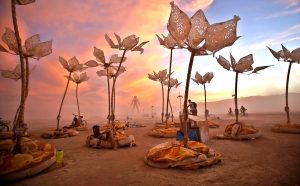 Yes, you have the likes of Elon Musk, Larry Page and Jeff Bezos show up – but you also have the likes of Paris Hilton, Katy Perry, and Cara Delevingne prancing around. Everyone’s welcome!
Yes, you have the likes of Elon Musk, Larry Page and Jeff Bezos show up – but you also have the likes of Paris Hilton, Katy Perry, and Cara Delevingne prancing around. Everyone’s welcome!
Burning Man is not a festival for the poor and poverty-stricken – not by any means. Tickets alone cost nearly $400. Add to that the costs of getting into Black Rock Desert and surviving for several days in some of the harshest conditions on the planet; it’s safe to say that most Burners are middle class; many are super rich; and by global standards, almost all of them of them live a privileged life. That’s not to begrudge them any of it – it’s simply stating the reality.
What do I wear?
Wear whatever the fuck you want. Clothing is optional. Naked men and en déshabillé women with nipple pasties are not uncommon. Taut buttocks, perky tits, and flaccid penises with Prince Alberts become the new normal. There’s no body-shaming or slut-slamming. No one cares, no one stares, no one judges.
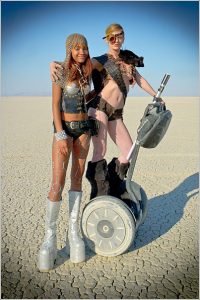 The outfits people wear are whimsical, phantasmagorical, and almost Pythonesque in some ways. It’s like the characters from Mad Max and Star Wars made the beast with two backs on the sets of Alice in Wonderland and the numerous progeny from this sexual encounter somehow found their way to Black Rock Desert.
The outfits people wear are whimsical, phantasmagorical, and almost Pythonesque in some ways. It’s like the characters from Mad Max and Star Wars made the beast with two backs on the sets of Alice in Wonderland and the numerous progeny from this sexual encounter somehow found their way to Black Rock Desert.
At Burning Man you’ll meet people in Zulu warrior outfits, mesh-covered holographic bodysuits, yoga pants and fairy tights, leopard-print leather thongs, cowl-hooded Jedi robes, cap-and-bell jester hats, cyber-punk onesies, fibre-optic LED jackets, ballet-bae platforms, gypsy lynx skirts, glow-in the-dark rave bras, cyber-goth corsets… and add to it bindis, bangles, boas and togas and you get an idea of how giddily mad and deliriously eclectic the outfits at Burning Man are.
It’s a case of post-apocalyptic fashion meets Bohemian-glam meets neo-Victorian meets cosplay-Manga meets futuristic-hippy meets avant-garde steampunk. From Tribal to Bridal and Bondage to Burlesque – everything goes at Burning Man. The only item of clothing that is common to almost everyone is a scarf to swaddle around the face during a dust storm. (The dust isn’t really dust – and it isn’t quite sand. It’s the alkaline remnants of an ancient lake.)
So, yes, if you’re going to Burning Man, be prepared to be accosted and hugged by all manner of sweaty dusty people in all kinds of outrageous outfits – or no outfits at all – just human bits and bobs and birthday suits.
So what do you do in Burning Man?
You can do whatever the fuck you want at Burning Man. The 2016 festival directory has a list of hundreds and thousands of workshops, parades, games, performances, parties, support groups, ceremonies, and parties: Drum-building, electric-jousting, giant Jenga, friendship ceremonies, nipple decoration, piano tuning, bondage, cross-dressing, erotic massages, TED talks, Renaissance Maker Spaces, stilt-walking, fire orchestras, spiritual healing, mask-making, light paintings, porn and donuts, hula-hooping, naked yoga, orgy domes, spoken word poetry slams, karaoke, blow jobs for beginners, fossil hunting, foot washing, spirit animal gatherings, gender burning, herbal facials, shamanic chanting, dominatrix for dummies, wine bars, cocktail hours, movie nights, whiskey tasting, booty pageants, holotropic breathing, fire dodgeball, confessionals, workshops, concerts… the list of things to do at Burning Man is virtually endless! And here’s the key – it’s all free! There’s no exchange of money – and there’s no barter system. Burning Man is based on a Gifting Economy. You do things for your fellow human beings out of the goodness of your heart and without expectation of anything in return. You use your skills, talents, intelligence, abilities and experiences to bring richness, joy, and wonder into the lives of others.
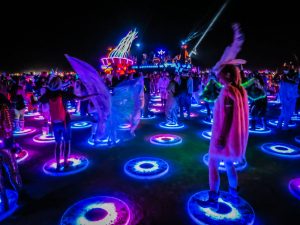 This kind of radical gifting is uplifting and infectious and serves as a spur to make new and meaningful connections immediately with complete strangers. You could choose to show up with nothing and still survive on the generosity of others. But that would detract immensely from the joy of giving.
This kind of radical gifting is uplifting and infectious and serves as a spur to make new and meaningful connections immediately with complete strangers. You could choose to show up with nothing and still survive on the generosity of others. But that would detract immensely from the joy of giving.
There are no food courts, no convenience stores, no Wi-Fi, and no mobile service at Burning Man. The outside world (also known as ‘the default world’ in Burner lingo) seems a million miles away.
Obviously, it’s next to impossible to get through everything that Burning Man has to offer. The three most popular things to experience at Burning Man probably are: the art installations, the mutant vehicle art cars, and the music lounges and dance clubs.
The Art Installations
The art installations at BM are as weird as they are beautiful, as futuristic as they are magical, as psychedelic as they are unearthly. In a striking combination of cyberpunkery, unfettered Dadaistic nihilism, and preternatural whimsy, the installations at BM arrest the unsuspecting viewer and draw them into an alternative world of indie-spiritualism, techno-mythology, and a subculture of impish wonder and puckish play. For inspiration, artists draw upon Grecian mythology, eastern mysticism, psychotropic art, Industrial Revolution and upon the ever-pertinent themes of love, life, youth, mortality, death, and wonder. The materials they use are a fanciful combination of wood, steel, plastic, and glass – and of course, everything has to be swathed in a trance-inducing flux of LED lights to ensure that the pieces are visible even at night.
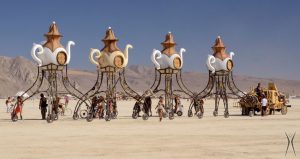 This year’s art theme was ‘Da Vinci’s workshop’ and drew upon the historic convergence of art, innovation and enlightened patronage that erupted in Europe during the Italian renaissance. The featured projects attempted to recreate this fusion of art, science, creativity, imagination, ingenuity, engineering, and technology, thus making black rock city the epicentre of a novo renaissance.
This year’s art theme was ‘Da Vinci’s workshop’ and drew upon the historic convergence of art, innovation and enlightened patronage that erupted in Europe during the Italian renaissance. The featured projects attempted to recreate this fusion of art, science, creativity, imagination, ingenuity, engineering, and technology, thus making black rock city the epicentre of a novo renaissance.
This year, there were gigantic wooden apes; a modern interpretation of the Medusa in steel; a crystal-like cluster of lighthouses ranging from 6 to 60 foot tall; a garden of burning metallic mushrooms; a psychedelic mechanical model of the solar system; a reverse hourglass with translucent pellets that flow upwards; a clockwork bacteriophage; a gutted 747 jetliner; and so much more! Seemingly infinitely more! The mind reels at the prospect of soaking in so much art, so much ingenuity….
MoMA and the other Art Museums are great – but they are so structured, so defined , so… restrictive. The viewer is separated from the art. The artist is nowhere to be seen. The pieces of art are curated by some “expert” or the other. Each piece of art is valued in the millions of dollars. There is a disconnect between the art, the artist, and the viewer. We are told what we ought to like. We are told that this is good art and that is high art. But the art itself is disconnected from us.
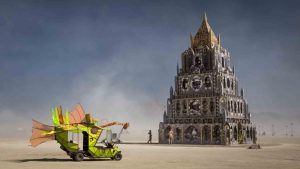 How different it is at Burning Man. There you get to interact with the art. You get to talk to the artist. There is no one there telling you what you may display and what you may not. There is no “expert” curator deciding what you may or may not see. At BM, the landscape becomes the artist’s canvas. You are a part of the art. The viewer becomes a component of the artwork. And unlike MoMA and other galleries, all the art in BM is free. It’s a wonderful illustration of ars gratia artis (Art for art’s sake). And unlike your Van Goghs and Rembrandts that are preserved for centuries, the art at BM lasts only until the end of that year’s festival. Then it is dismantled or burned and it’s gone forever… The temporal, fleeting, ephemeral nature of the art at BM makes it all the more precious and makes your enjoyment of it all the more pressing and urgent. It makes the art immediate and contiguous – as if you were connected to it in some ways.
How different it is at Burning Man. There you get to interact with the art. You get to talk to the artist. There is no one there telling you what you may display and what you may not. There is no “expert” curator deciding what you may or may not see. At BM, the landscape becomes the artist’s canvas. You are a part of the art. The viewer becomes a component of the artwork. And unlike MoMA and other galleries, all the art in BM is free. It’s a wonderful illustration of ars gratia artis (Art for art’s sake). And unlike your Van Goghs and Rembrandts that are preserved for centuries, the art at BM lasts only until the end of that year’s festival. Then it is dismantled or burned and it’s gone forever… The temporal, fleeting, ephemeral nature of the art at BM makes it all the more precious and makes your enjoyment of it all the more pressing and urgent. It makes the art immediate and contiguous – as if you were connected to it in some ways.
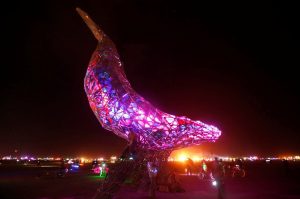 To some, the burning of art may seem extravagant and wasteful. But to others it is an act of catharsis and spiritual sublimation. In our default life, we cling so deeply to material possessions and place so much importance on the things we fashion. The lesson we learn from BM is to live for the present and to avoid clinging emotions and sickly attempts at ownership of the things we love. The artist creates, but the creation then no longer belongs to the artist; it belongs to the world and the viewer is free to interpret, explain, analyse, and experience it in any way they like. And at the end of BM the art ceases to exist too – just like life.
To some, the burning of art may seem extravagant and wasteful. But to others it is an act of catharsis and spiritual sublimation. In our default life, we cling so deeply to material possessions and place so much importance on the things we fashion. The lesson we learn from BM is to live for the present and to avoid clinging emotions and sickly attempts at ownership of the things we love. The artist creates, but the creation then no longer belongs to the artist; it belongs to the world and the viewer is free to interpret, explain, analyse, and experience it in any way they like. And at the end of BM the art ceases to exist too – just like life.
One of the installations I particularly liked was a green double-helix with a flower in the shape of a heart at the top. You climb up the rungs of the double helix and you can sit inside the heart-flower. The centrepiece of the experience inside the heart are two heart sensors, each controlling the 1,000 LEDs. Touching each heart sensor illuminates all of the LEDs on its side, allowing you and the person you’re with to directly experience each other’s pulse. This personalises the experience and brings everyone inside the heart closer together in a moment of beautiful reflection.
Inside the flower-heart was this beautiful poem about love:
Each has a unique path
That never stoops moving
And never stops growing.
Each supports themselves first
Then extends support to the other.
As they grow together
The whole becomes stronger
Than the sum of its parts.
As partners in life
Their collective consciousness
Has reached a new level
They didn’t fall in love.
They ascended to it.
The artist was Jeremy Richardson, an MIT graduate and a self-described designer, engineer, and entrepreneur. We spoke to him at BM and he said the installation was inspired by and dedicated to his two friends who didn’t fall in love – but ascended into it. It was very touching.
Mutant Vehicles and Art Cars
The mutant vehicles (modified cars) are one of the most ubiquitous and striking elements of BM. They must pass the criteria set by Burning Man’s Department of Mutant Vehicles (DMV) to be granted a festival license. This means they must be completely mutated – showing little or none of the original base vehicle.
With each passing year, the art cars are becoming more phantasmagorical, more grotesque, more delightful, more expensive, and more sophisticated. You’ll see an art car that is a giant rubber duck, or a flame-breathing metallic octopus, or an open-jawed fish with fangs. Perhaps the most wondrous art car at this year’s BM that filled me with absolute awe and amazement was this car that had been modified into a colossal fifty-foot high pirate ship – complete with rigs and sails and mast. To see it sailing along the dusty plains of Black Rock Desert was truly a marvellous sight.
The Marriage
While we were at Burning Man, we were fortunate enough to attend the wedding of Ron and Desha on the playa – the deep playa. Burning Man is such a sprawling metropolis that the best (and often the only) way to get around is on bicycles. The wedding party guests donned their ski goggles and swathed their faces with scarves and rode en masse into the deep playa – an area far beyond what is shown on the BM map. Burners take it upon themselves to leave random art installations and chill spaces randomly throughout this vast area. So you may be cycling along for 5 minutes without seeing anything before coming across an oasis of couches, umbrellas and lemonade.
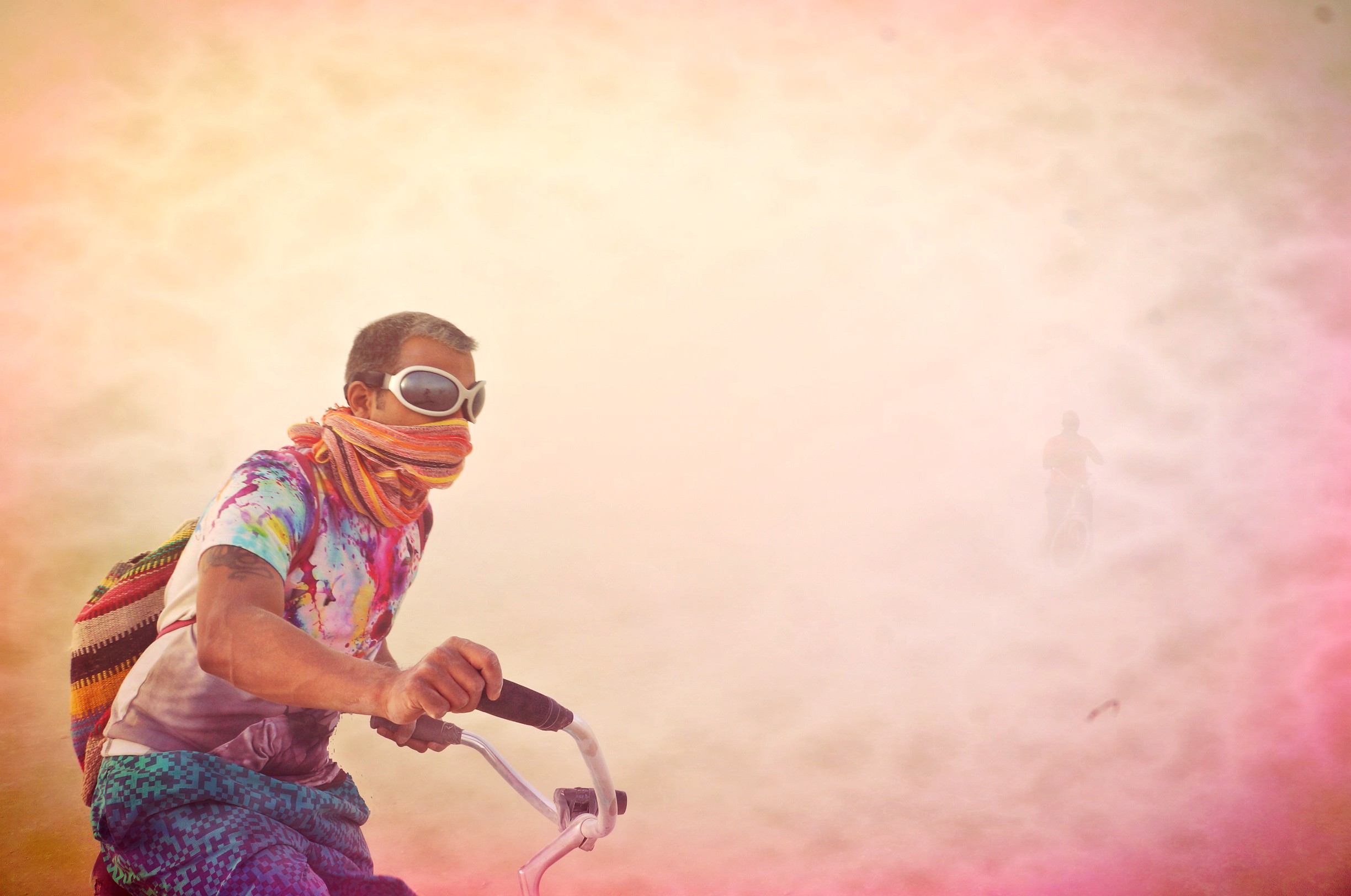 We rode and rode – through a massive dust storm and an eerie white-out, until we reached the special venue for the wedding: a tall mobile gramophone that doubles as a sound system and cabaret stage. Called La Victrola, the art float is a larger-than-life crank turntable that occasionally moves around Black Rock City, playing scratchy gramophone records from a by-gone era of speakeasies, vaudeville, and bluegrass from its 3,500 lb horn speaker.
We rode and rode – through a massive dust storm and an eerie white-out, until we reached the special venue for the wedding: a tall mobile gramophone that doubles as a sound system and cabaret stage. Called La Victrola, the art float is a larger-than-life crank turntable that occasionally moves around Black Rock City, playing scratchy gramophone records from a by-gone era of speakeasies, vaudeville, and bluegrass from its 3,500 lb horn speaker.
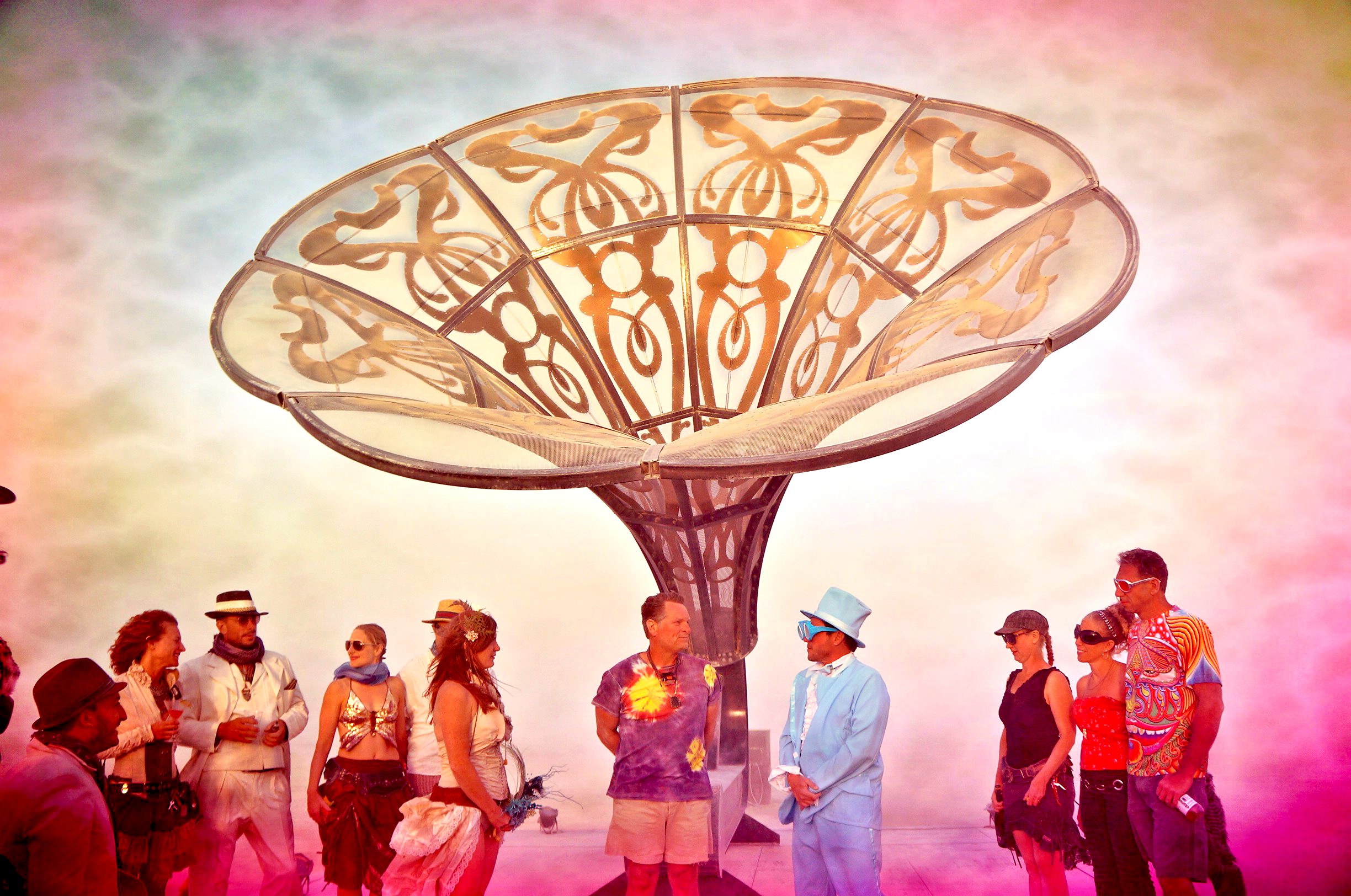 What is wonderful about the weddings on the playa is that they are so non-commercial – so unconventional – so… maverick and eccentric. There was Ron, in his baby blue tux, top hat, and Elton John glasses. And there was Desha, in her dusty boots, open-front fluffy skirt, beige panties, and leather belt. It was a simple ceremony, with a motley group of friends, and a brief exchange of vows solemnised by the unofficial official priest.
What is wonderful about the weddings on the playa is that they are so non-commercial – so unconventional – so… maverick and eccentric. There was Ron, in his baby blue tux, top hat, and Elton John glasses. And there was Desha, in her dusty boots, open-front fluffy skirt, beige panties, and leather belt. It was a simple ceremony, with a motley group of friends, and a brief exchange of vows solemnised by the unofficial official priest.
At Burning Man, every installation offers inspiration for the sacred and the divine. In this case, for Ron and Desha, it was a massive Phonograph made of metal and steel.
The Temple
Of everything that Burning Man had to offer, I was touched most profoundly by the Temple. Burning Man is, indeed, a bacchanalian celebration and one of the greatest parties on the planet; but many also come to Burning Man to grieve and commemorate the loss of their loved ones. The Temple is an integral fixture of the Burning Man landscape. Each year offers a new design built by artist David Best.
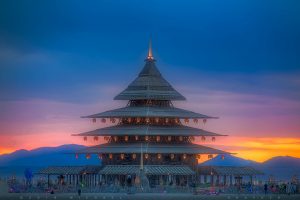 The temple and its environs are a stark contrast to the madness, frivolity, and wanton gaiety of the rest of Burning Man. The temple doesn’t espouse any religion and is simply a place for people to grieve. People mourn with dignity and a depth of emotion that really has a profound impact on the casual observer. Here, as at the rest of Burning Man, no one judges, no one condemns. Everyone is welcome. It is not unusual to see a grandfather in a pink tutu and orange wig weeping inconsolably over a picture of a loved one. I saw a nude young lady with rainbow stockings and tattooed arms sobbing in silence. I heard a young man in a leather skirt exhaling violently and repeatedly: “Hhhhraaaahhh! Hhhhhraaaah!” As if it was his way of expelling an awful circumstance or a painful memory. No one laughed. No one stared. No one judged. My only thought was, “Brother, if this is what you need to do to deal with your pain, then you go ahead and do it. You do what you have to do to heal.”
The temple and its environs are a stark contrast to the madness, frivolity, and wanton gaiety of the rest of Burning Man. The temple doesn’t espouse any religion and is simply a place for people to grieve. People mourn with dignity and a depth of emotion that really has a profound impact on the casual observer. Here, as at the rest of Burning Man, no one judges, no one condemns. Everyone is welcome. It is not unusual to see a grandfather in a pink tutu and orange wig weeping inconsolably over a picture of a loved one. I saw a nude young lady with rainbow stockings and tattooed arms sobbing in silence. I heard a young man in a leather skirt exhaling violently and repeatedly: “Hhhhraaaahhh! Hhhhhraaaah!” As if it was his way of expelling an awful circumstance or a painful memory. No one laughed. No one stared. No one judged. My only thought was, “Brother, if this is what you need to do to deal with your pain, then you go ahead and do it. You do what you have to do to heal.”
Burning Man is an assault on all your senses. Entering the temple with its pictures of deceased grandparents, lost children, dead pets and its heart-wrenching messages written to loved ones is a sombre and sobering experience. Many who come to Burning Man have no traditional religious affiliation. The Temple provides a sanctuary for those of us who are spiritual but have rejected what traditional religions have to offer.
Burning Man reaches its culmination with the burning of the Temple on the last and final night. This usually takes place in silence except for people calling out the names of the deceased and their loved ones. The burning is cathartic. It is symbolic of our connection with the rest of the universe. But most importantly, it offers closure to those who have lost someone dear to them.
I am deeply moved, even now, at the thought of how profoundly I was affected by the visit to the Burning Man temple. The grief I saw there was not one of despair. It was a healing grief. It was an empowering grief. It was a grief that would allow people to grow stronger and return to the default world with confidence and optimism for the future.
The Man
What is amazing about Burning Man is not just the absence of money (you simply don’t need your wallet or credit card) it’s the absence of any form of commercialisation or advertising. In fact, Burners delight in subverting popular brands (stickers on the porta-potties have symbols of Apple with the word “iPoop” beneath; and Burger King becomes Burner King).
Many wonder what the significance of the burning “Man” at the centre of Black Rock City is. The Man could be a symbol or metaphor for everything we want to get rid of in the default world: commercialisation, exploitation, conformity, injustice, poverty, the herd instinct, dirty politics… Hence the Burning of the Man…. Burning Man.
A Better World
Ultimately, Burning Man is an example of what humans are capable of when our basic desires are met and when our fundamental problems of subsistence are ameliorated. Burners are people who are fairly high up on Maslow’s Hierarchy of needs. In their regular life they have good jobs, adequate homes, access to information, access to healthcare, a network of friends, and most importantly, never have to worry about where their next meal is coming from. Burning Man is a classic example of the heights to which the human spirit and human ingenuity can transcend when resources are plentiful.
The love, warmth, and generosity of Burning Man are possible only because of its transience and temporary nature. Such a community cannot last permanently. All the age-old evolutionary baggage we carry with us – envy, jealousy, greed, anger, hatred, lust, vengeance, desire for dominance, struggle for power… would seep through sooner or later the longer a community like BM exists contiguously; which is why it is important that Burning Man must be a temporary experiment each year.
Yes, BM is a latter-day Shangri-La. But it is destined to remain a temporary week-long Shangri-La – at least for the foreseeable future. If there’s anything we learn from novels such as Heart of Darkness, Lord of the Flies, and particularly, The Beach, it is that there is no permanent paradise and that human nature is deeply flawed and full of imperfections.
It is a testament to the resilience and determination of the human spirit that in spite of all our flaws a festival like Burning Man exists and has existed for nearly two decades. 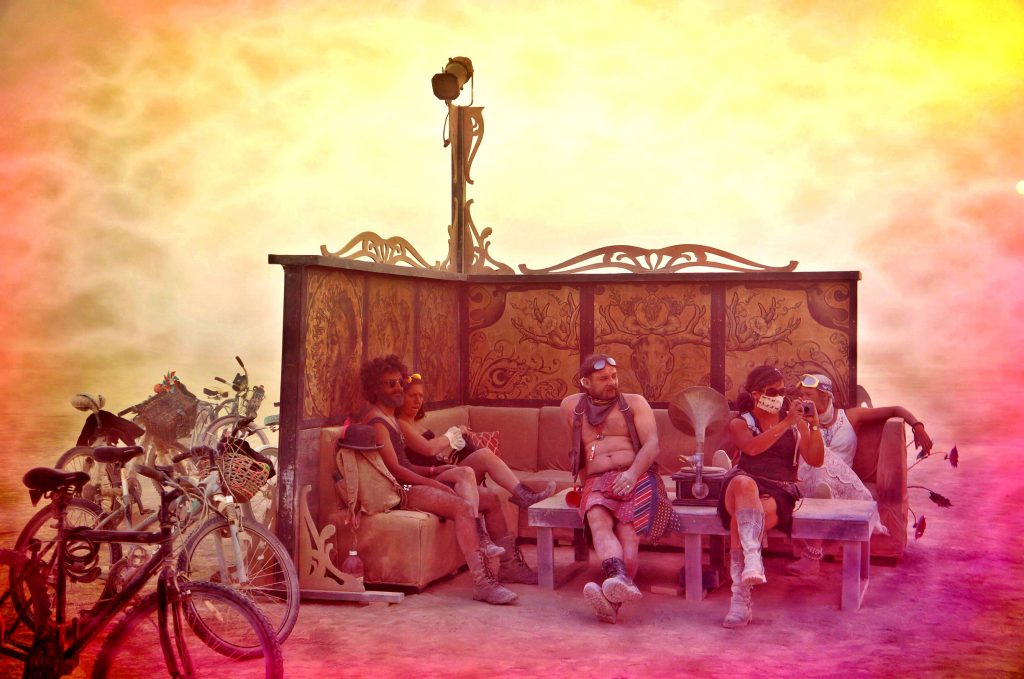 BM offers important life lessons.
BM offers important life lessons.
It helps people connect authentically with themselves and with the people around them. People who leave Black Rock City and go back to the default world become stewards of the planet and are good to their neighbours. It is a place of values and principles. Marian Goodell, CEO of Burning Man Project, says, “If things went sideways on the planet – if no one trusted authority and religion wasn’t the place for people – I have a real belief that some of the festival community would look to each other to solve things, through the experiences that we’ve learned by living together at events such as Burning Man.”
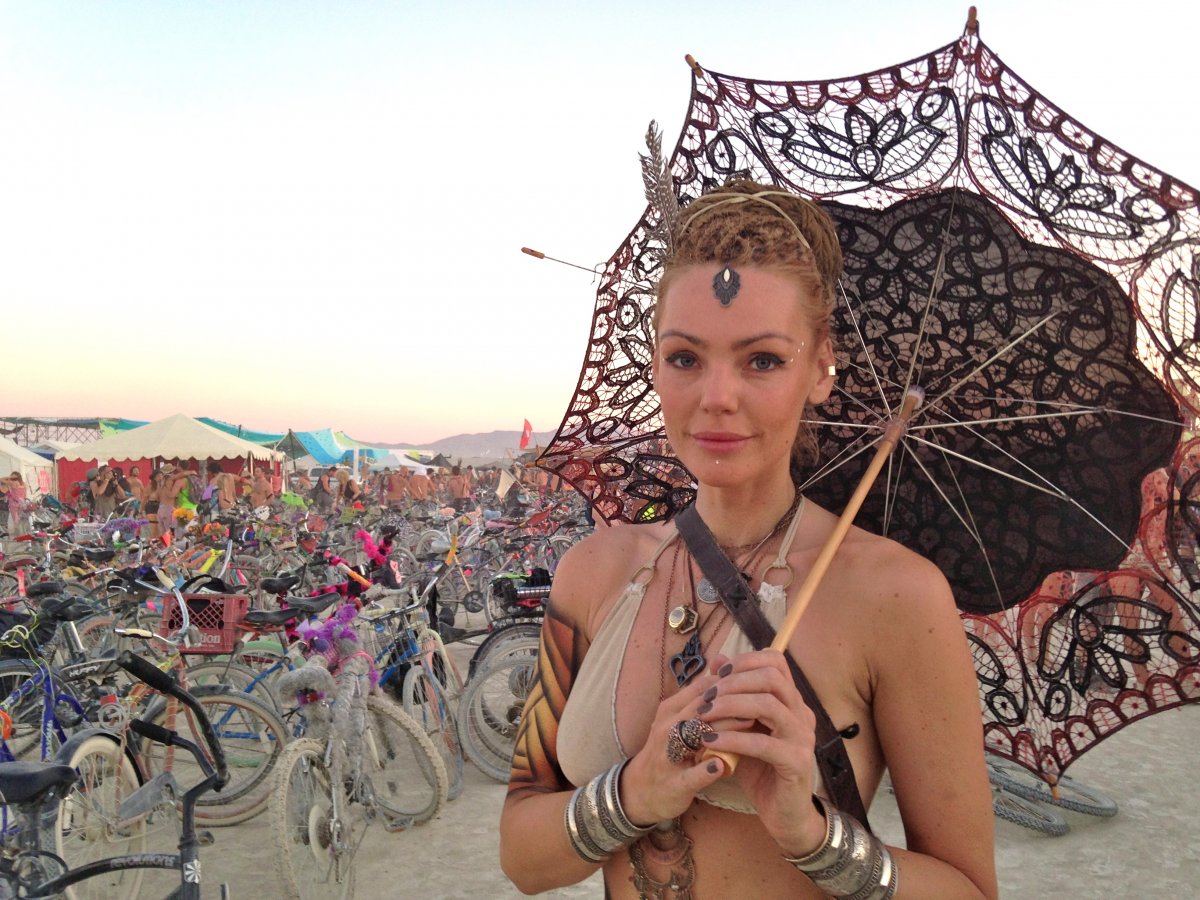 Burning Man is a full-frontal encounter with all aspects of the human conditions. Burning Man is a concentration of the entire spectrum of human emotions. It is a microcosm of the world as it ought to be: sharing, creative, communal, and free from commercialisation, mass production, merchandising and cheap imitation; a place of radical freedom and radical self-expression. Ultimately, BM is a celebration of the individual just as much as it is a celebration of human diversity.
Burning Man is a full-frontal encounter with all aspects of the human conditions. Burning Man is a concentration of the entire spectrum of human emotions. It is a microcosm of the world as it ought to be: sharing, creative, communal, and free from commercialisation, mass production, merchandising and cheap imitation; a place of radical freedom and radical self-expression. Ultimately, BM is a celebration of the individual just as much as it is a celebration of human diversity.
I didn’t soak in even 1% of what BM has to offer – and yet I’m a shaken wreck by what I witnessed there. I am a changed man.
If anyone wonders what humans will get up to when everything is automated and when the machines and Super A.I.s take over all our regular work – my response is that I hope the world will become one big Burning Man – where every man, woman and child will use their free time productively and be able to express themselves through their art, ventilate their creativity, give utterance to their deepest thoughts, express their dearest hopes, dreams and ambitions – and most importantly, celebrate all the freedoms of the human spirit.
Burning Man is bizarre. Burning Man is outrageous. Burning Man is everything that is good and great about the human species. Burning Man gives me hope in humanity.
Special Thanks: Big up and props to Artin and Ahrin for supporting us and mentoring us at our first Burn and for all the hard work they put into making this happen!
Check out this awesome video about Burning Man! Truly Sublime!
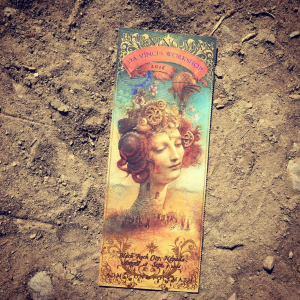
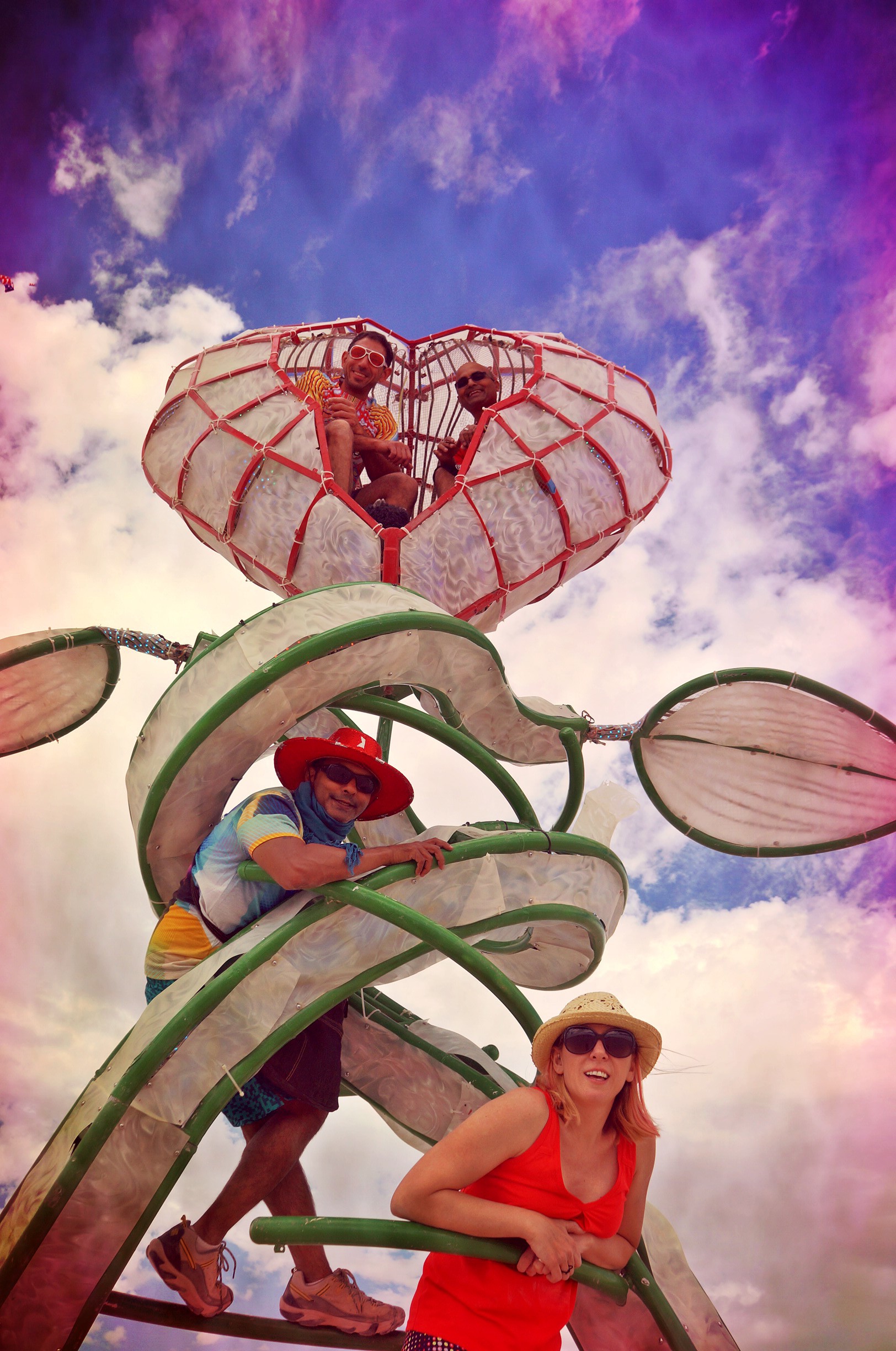
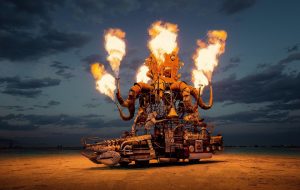
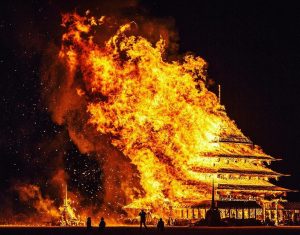
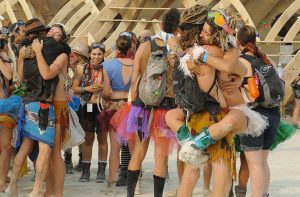

There are very few writers who can capture my imagination and interest within the first few lines of thought.
Rohan Roberts is one among them.
Superb reportage, Rohan! For the uninitiated, like me, your account gives
one a complete insight into the complex and subliminal nature of this one-of-a-kind annual celebration of human creativity, inegenuity and warm, altriuistic, no strings attached generosity!
This is a fantastic piece of writing Rohan. It truly captures the spirit and purpose of Burning Man, from my perspective. I first went in 2000. Our camp, Singularity Point, offered the first transhumanist speaker series and library on the playa, to my knowledge. In years since, some of the deepest conversations I’ve ever had about the purpose of life and our relationship to a world of accelerating technology have happened on the playa. I recommend everyone go to BM at least once, if they can. Some feel called to go back again and again, others to take what they learned and use it elsewhere. In either case, you’ll be forever changed, if you go at least once, with an open mind and heart.